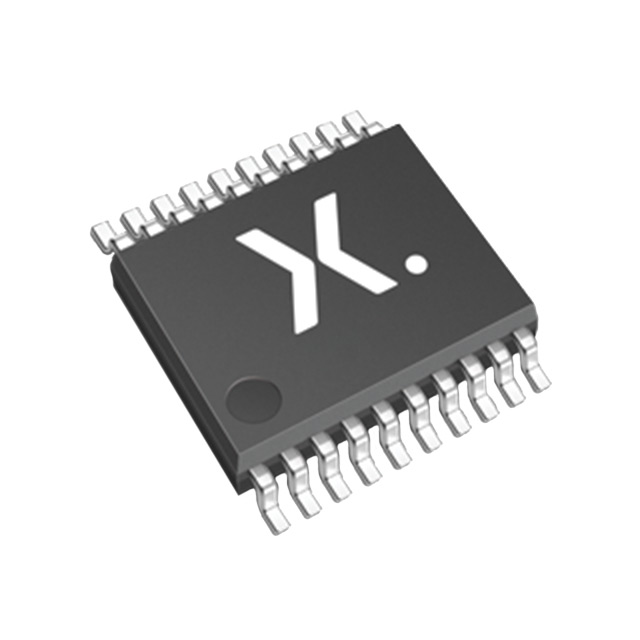Consulte las especificaciones para obtener detalles del producto.

Encyclopedia Entry: 74VHC245PW,118
Product Overview
- Category: Integrated Circuit (IC)
- Use: Signal Level Shifter
- Characteristics: High-Speed, Low-Power, Non-Inverting, Octal Bus Transceiver
- Package: TSSOP (Thin Shrink Small Outline Package)
- Essence: This IC is designed to shift the logic levels of signals between different voltage domains in electronic circuits.
- Packaging/Quantity: The 74VHC245PW,118 is typically sold in reels containing 2,500 units.
Specifications
- Supply Voltage Range: 2.0V to 5.5V
- Logic Family: VHC (Very High-Speed CMOS)
- Number of Channels: 8
- Input/Output Compatibility: TTL, LVTTL, and CMOS
- Propagation Delay: 4.3 ns (typical)
- Operating Temperature Range: -40°C to +125°C
Detailed Pin Configuration
The 74VHC245PW,118 has a total of 20 pins, which are assigned as follows:
- OE (Output Enable) - Active LOW Output Enable Input
- A1 - Data Input/Output Channel 1
- B1 - Data Input/Output Channel 1
- A2 - Data Input/Output Channel 2
- B2 - Data Input/Output Channel 2
- A3 - Data Input/Output Channel 3
- B3 - Data Input/Output Channel 3
- A4 - Data Input/Output Channel 4
- B4 - Data Input/Output Channel 4
- GND (Ground)
- B5 - Data Input/Output Channel 5
- A5 - Data Input/Output Channel 5
- B6 - Data Input/Output Channel 6
- A6 - Data Input/Output Channel 6
- B7 - Data Input/Output Channel 7
- A7 - Data Input/Output Channel 7
- B8 - Data Input/Output Channel 8
- A8 - Data Input/Output Channel 8
- VCC (Supply Voltage)
- DIR (Direction Control) - Input for Direction Control
Functional Features
- Non-Inverting Bidirectional Data Transfer: The IC allows bidirectional data transfer between two voltage domains without inverting the logic levels.
- High-Speed Operation: It is designed to operate at high speeds, making it suitable for applications requiring fast data transmission.
- Low Power Consumption: The IC consumes low power, making it energy-efficient and suitable for battery-powered devices.
- Wide Supply Voltage Range: It can operate within a wide range of supply voltages, providing flexibility in various electronic systems.
Advantages and Disadvantages
Advantages: - Non-inverting bidirectional data transfer simplifies circuit design. - High-speed operation enables efficient data transmission. - Low power consumption prolongs battery life. - Wide supply voltage range enhances versatility.
Disadvantages: - Limited number of channels (8) may not be sufficient for complex systems requiring more connections. - Propagation delay of 4.3 ns may introduce timing issues in certain applications.
Working Principles
The 74VHC245PW,118 operates based on CMOS technology. It utilizes a combination of MOSFET transistors to shift the logic levels of signals between different voltage domains. The direction of data transfer is controlled by the DIR pin. When the DIR pin is HIGH, data flows from the A-side to the B-side, and when it is LOW, data flows in the opposite direction.
Detailed Application Field Plans
The 74VHC245PW,118 is commonly used in various electronic systems where logic level shifting is required. Some of its typical applications include: - Interfacing between microcontrollers operating at different voltage levels. - Level translation between different logic families (TTL, LVTTL, and CMOS). - Signal buffering and isolation in communication interfaces. - Data transmission between memory modules and processors.
Detailed and Complete Alternative Models
- SN74LVC245A: Octal Bus Transceiver with 3-State Outputs
- CD74HCT245: High-Speed CMOS Logic Octal Bus Transceiver
- MC74VHC245: Octal Bus Transceiver with 3-State Outputs
These alternative models offer similar functionality to the 74VHC245PW,118 and can be considered as replacements based on specific requirements.
Word Count: 511 words
Enumere 10 preguntas y respuestas comunes relacionadas con la aplicación de 74VHC245PW,118 en soluciones técnicas
Sure! Here are 10 common questions and answers related to the application of 74VHC245PW,118 in technical solutions:
Q: What is the function of the 74VHC245PW,118? A: The 74VHC245PW,118 is an octal bus transceiver that can be used to enable bidirectional transfer of data between two buses.
Q: What is the voltage supply range for the 74VHC245PW,118? A: The 74VHC245PW,118 operates with a voltage supply range of 2.0V to 5.5V.
Q: Can the 74VHC245PW,118 handle level shifting between different voltage domains? A: Yes, the 74VHC245PW,118 can be used for level shifting between different voltage domains as long as the voltage supply range is within its specified limits.
Q: How many data lines can the 74VHC245PW,118 handle? A: The 74VHC245PW,118 can handle 8 bidirectional data lines.
Q: What is the maximum data transfer rate supported by the 74VHC245PW,118? A: The 74VHC245PW,118 can support data transfer rates up to 200MHz.
Q: Does the 74VHC245PW,118 have any built-in protection features? A: Yes, the 74VHC245PW,118 has built-in ESD protection on all inputs and outputs.
Q: Can the 74VHC245PW,118 be used in both parallel and serial communication systems? A: Yes, the 74VHC245PW,118 can be used in both parallel and serial communication systems, depending on the application requirements.
Q: What is the typical propagation delay of the 74VHC245PW,118? A: The typical propagation delay of the 74VHC245PW,118 is around 4.5ns.
Q: Can the 74VHC245PW,118 be used in high-speed applications? A: Yes, the 74VHC245PW,118 is designed for high-speed operation and can be used in various high-speed applications.
Q: Are there any specific layout considerations when using the 74VHC245PW,118? A: Yes, it is recommended to follow proper PCB layout guidelines to minimize noise and ensure signal integrity when using the 74VHC245PW,118.
Please note that these answers are general and may vary based on specific application requirements and datasheet specifications.

